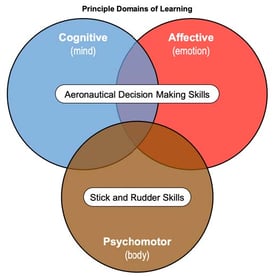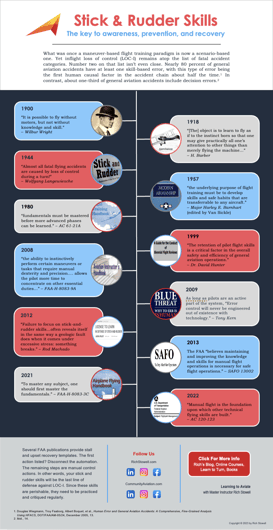Learning to Aviate with Rich Stowell
My specialty has always been spin, emergency maneuver, and aerobatic training. I don’t provide primary flight instruction. But I’ve seen the result of our flight training system in pilots who have been left unconfident, confused, even scared. Pilots who are eager to learn, but whose basic flying skills are underdeveloped. What are you seeing? How do you feel about your stick and rudder skills?
As recently as November 2022, the FAA wrote that manual flying skills are “the foundation upon which other technical skills are built.”[1] That it is “essential that knowledge and both cognitive and psychomotor skills for [manual flight operations] are developed from the beginning of pilot training and practiced throughout a pilot’s career.”[2]
Weird: The FAA continues to emphasize the the importance of manual flying skills, while the European Aviation Safety Agency (EASA) is calling for the use of more automation. LINK
Manual flying skills in space? Read how Neil Armstrong Saved the Day on the Moon. LINK

Stick and rudder (SAR) skills are developed in the psychomotor domain of learning. But practicing a series of control movements without context or purpose (other than to pass a check ride) won’t get us to the correlation level of learning. Moreover, manual flying skills alone won’t help us achieve peak performance in the air.
Nailed it: “What makes flying so difficult is that the flier's instincts—that is, his most deeply established habits of mind and body—will tempt him to do exactly the wrong thing.” Wolfgang Langewiesche, Stick and Rudder (McGraw-Hill, 1944), 3.
Scenario-based training overlaps the cognitive and affective domains of learning. This is where aeronautical decision-making (ADM) skills like risk management and situational awareness are developed. But ADM skills alone won’t help us achieve peak performance, either. And dealing with complex scenarios becomes more difficult when we’re preoccupied with the mechanics of flying.
 The current scenario-based training paradigm replaced a maneuvers-based one decades ago. Still, inflight loss of control (LOC-I) remains the top fatal accident category. Number two on the list isn’t even close. Nearly 80 percent of general aviation accidents have at least one skill-based error.[3] And a skill-based error is the first human causal factor in the accident chain about half the time. In contrast, only about one-third of general aviation accidents include decision errors.[4]
The current scenario-based training paradigm replaced a maneuvers-based one decades ago. Still, inflight loss of control (LOC-I) remains the top fatal accident category. Number two on the list isn’t even close. Nearly 80 percent of general aviation accidents have at least one skill-based error.[3] And a skill-based error is the first human causal factor in the accident chain about half the time. In contrast, only about one-third of general aviation accidents include decision errors.[4]
Has the pendulum swung too far toward scenarios? Does scenario-based training assume that manual flying skills will evolve on their own? Does the way we’ve been teaching maneuvers lack relevance to real-world flying? With so much material to cover, are stick and rudder skills being short changed?
We of course need to develop both SAR and ADM skill sets. But realize that better stick and rudder skills enable better in-flight decision-making. The order and the intent of these facets of flight training matter. The Aviation Instructor’s Handbook seems to get this. It places “Acquiring Skill Knowledge” several sections ahead of “Scenario-Based Training.” If word count is any clue, the skill section has almost 40 percent more text than the scenario-based one.[5] The infographic puts the importance of stick and rudder skills into historical perspective.
This blog targets flight instructors. It also targets VFR pilots with fewer than 500 hours. Why instructors? Our job is to teach others how to fly, not how to pass a test. Plus, 91 percent of fatal stall-spins classified as “instructional” occur with one of us on board.[6]
Why pilots with fewer than 500 hours? They’re more likely to have a stall-spin accident than a genuine engine failure.[7] That is, LOC-I triggered by the pilot’s misapplication of the controls at a critical time.
Purpose: “To teach more about flying than how to steer an airplane; to take time with the students;
to offer them the priceless thing that is the ability to fly.” – Richard Bach, “School for perfection,” A Gift of Wings, 1974, 159.
I’ll post something every couple of weeks to start. I’ll usually talk about stick and rudder issues. Principles and practical skills to help you fly better. How-to stuff. Fun stuff. Sometimes plain old musings and critiques of things happening in aviation. Other times I might share work in progress for your feedback.
In Show Your Work, Austin Kleon writes: “As you put yourself and your work out there, you will run into your fellow knuckleballers... the people who share a similar mission to your own.” I’ve found this to be true throughout my flying career. I also like the reference to baseball pitchers who buck the trend of trying to throw ever faster. Instead of brute force, knuckleballers rely on aerodynamics to confound hitters. They put the time in to grasp the fundamentals of a unique pitch. And since they are few, knuckleballers feel a sense of community and a duty to share their tips with one another. I like that.
If this post resonates, you’re a fellow knuckleballer. If you believe stick and rudder skills are foundational, you’re a fellow knuckleballer. If your goal is to become a better pilot or better instructor, you’re a fellow knuckleballer. Welcome to the community!
____
[1] FAA, “Flightpath Management,” Advisory Circular 120-123, November 21, 2022, 3-1.
[2] Ibid., 3-5.
[3] Douglas Wiegmann, Troy Faaborg, Albert Boquet, et al., “Human Error and General Aviation Accidents: A Comprehensive, Fine-Grained Analysis Using HFACS,” DOT/FAA/AM-05/24, December 2005, 13.
[4] Ibid., 14.
[5] FAA, “Aviation Instructor’s Handbook,” FAA-H-8083-9B, 2020, 3-23–3-25, 3-31–3-32.
[6] AOPA Air Safety Foundation, Stall/Spin: Entry Point for Crash and Burn?, 2003, 4. Available https://download.aopa.org/epilot/2008/stall-spin.pdf.Trivia: the photo in the header of this report was taken as part of a 1990 article in AOPA Pilot on the Emergency Maneuver Training program. I’m flying CP Aviation’s Decathlon N5035N near Santa Paula, CA.
[7] Brent W. Silver, “Statistical Analysis of General Aviation Stall Spin Accidents,” SAE Technical Paper No. 760480, April 1976, 6–7. I’ve rounded off the hours to match a common marker used by insurance companies.
>> This post was written by a human <<
Sign up to receive an email whenever Rich Stowell publishes content